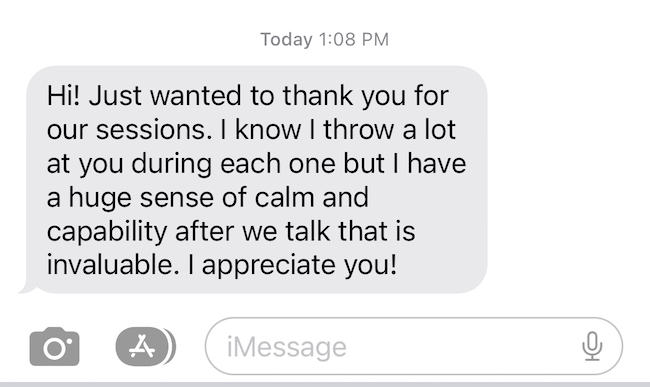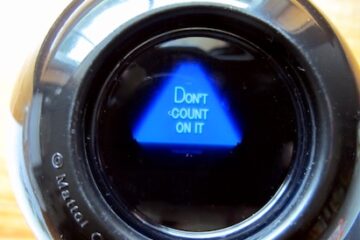The stabilizing influence in the room
Last week I had a very emotional session with one of my clients. They’ve gone through a lot of big changes recently and are facing more in the near future. There’s a lot of unknown, and that creates an anxiousness around lack of control and uncertainty about how best to move forward.
Later that day I got this text from that same client:

This made my day so thoroughly that I recorded a quick video about it while I was walking to the co-working space downtown.
My entire career, and most of my life, people have called me “the stabilizing influence in the room.”
Calmness is wonderful for coaching. It helps build trust. It helps me be a deep listener. It allows me to both empathize with my client but also maintain the detachment necessary to be their objective and rational partner.
At times over my career as a corporate leader, though, my calm has been my undoing.
Sometimes during a crisis, I can maintain such a calm attitude and approach that people get the wrong impression of me. They think that either I don’t understand how awful things are, or they think I don’t care about making it better.
I always care about making it better, especially if it truly is a crisis. (It’s not always as much a crisis as people think it is.)
And if it truly is a crisis, rarely does running around screeching about the sky falling help solve the crisis. More often, it makes the crisis worse because people make reactionary, poorly informed decisions without any thought to unintended consequences.
So, calm is almost always better than panic.
But people sometimes need a little frantic energy from their leaders in order to feel that actions are being taken by people who have the power to get things done.
Sometimes a little frantic energy from the leader—even if it’s merely performative—creates enough confidence to allow the panicking people to calm down enough to think rationally about solutions.
Also, nothing is an absolute.
That is, there have been times that indeed, I failed to realize the severity of a particular crisis, and my calm, methodical approach slowed me down to the point that the crisis worsened before I took action.
That’s when, as a leader, you want to have created an environment where everyone feels both empowered enough and safe enough to raise their concerns.
If you’re reactionary, make sure you have someone near you who is calm. If you’re overly calm, make sure you have someone near you who can raise the heat when you’re not reacting quickly enough. And give them the space and respect to do so. Ultimately the decision may rest with you, but in a crisis, it’s rarely better to rely entirely on one person’s singular view than on the mob mentality created by panic.
Huh. When I started writing this post it was simply going to be a fun “hey this Client said a Nice Thing!” post. I didn’t really mean for it to turn into a strengths-based leadership post.
But that’s just how my mind works, I guess.

I can help.
I work with top executives and middle managers to improve their leadership skills, their workplace culture, and the effectiveness of their teams. I also help individuals identify and achieve their personal goals. Would you like to become more aware, be more effective, be more empowered, and feel fully prepared for your next steps?
You can help.
Think of one person who would benefit from reading this post. Sharing is caring! Forward it to them right now. They will think you’re super smart and well informed.



1 Comment
Three simple tools of resilience - Gray Bear Coaching LLC · December 16, 2024 at 3:11 pm
[…] often been called the stabilizing influence in the room. Setbacks and crises rarely keep me down long. That’s not because I’m better than other […]